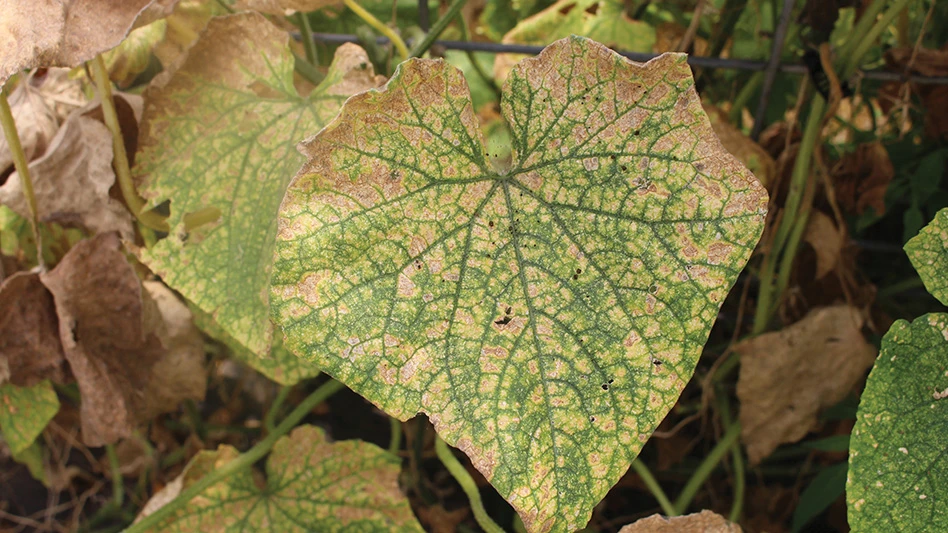

Greenhouse-grown cucumbers are susceptible to the twospotted spider mite Tetranychus urticae. It’s a major pest of greenhouse-grown cucumbers due to:
- multiple generations occurring during the growing season
- short generation time (life cycle)
- high female reproductive capacity
- a developed resistance to miticides
The twospotted spider mite has a life cycle consisting of four life stages: egg, larva, nymph and adult. The life cycle can be completed in five to seven days when temperatures exceed 80° F (26° C). Hot, dry conditions favor twospotted spider mite population growth. Adult females are approximately 1/60 inches in length. Eggs laid on leaf undersides are small, shiny, spherical and straw-colored. Eggs hatch into yellow-green, six-legged larvae that quickly mature into eight-legged nymphs and then adults.

Twospotted spider mites are primarily located and feed on leaf undersides because they are susceptible to ultra-violet light desiccation. A single leaf may harbor hundreds of individual spider mites. Feeding causes damage often referred to as “stippling” or “speckling.” Infested leaves turn yellow with distinct interveinal yellowing or chlorosis on the upper leaf surface. Leaf undersides are tan to yellow with a crusty texture. High populations result in mites climbing up plants and producing strands of webbing, which allows mites to move between plants. Look for mites by inspecting leaf undersides using a 10X or 16X hand-lens and by shaking leaves over a clipboard with a white sheet of paper (8 x 11 inches) and look for moving specks.
Miticides may be applied to suppress mite populations; however, thorough coverage of all plant parts is important, especially leaf undersides. Furthermore, twospotted spider mites develop resistance to miticides in a short time due to the frequency of miticide applications and multiple generations being present simultaneously. Always rotate miticides with different modes of action within a generation. In some instances, spot spraying localized infestations of twospotted spider mites may be effective in reducing the potential for resistance development and may also help avoid the spread of mites throughout the cucumber crop. The use of pyrethroid insecticides may increase female reproductive rate and dispersal of twospotted spider mites.
Natural enemies or biological control agents, such as the predatory mite Phytoseiulus persimilis, can be purchased from most biological control suppliers and released onto a cucumber crop to regulate twospotted spider mite populations. Predatory mites must be released early in the crop production cycle to maintain twospotted spider mite populations below damaging levels. However, the trichomes on cucumber leaves may inhibit the searching efficiency or ability of the predatory mite to locate and consume twospotted spider mites.

Explore the June 2023 Issue
Check out more from this issue and find your next story to read.
Latest from Produce Grower
- TIPA Compostable Packaging acquires paper-based packaging company SEALPAP
- Divert, Inc. and General Produce partner to transform non-donatable food into Renewable Energy, Soil Amendment
- [WATCH] Sustainability through the value chain
- Growing leadership
- In control
- The Growth Industry Episode 8: From NFL guard to expert gardener with Chuck Hutchison
- 2025 in review
- WUR extends Gerben Messelink’s professorship in biological pest control in partnership with Biobest and Interpolis





